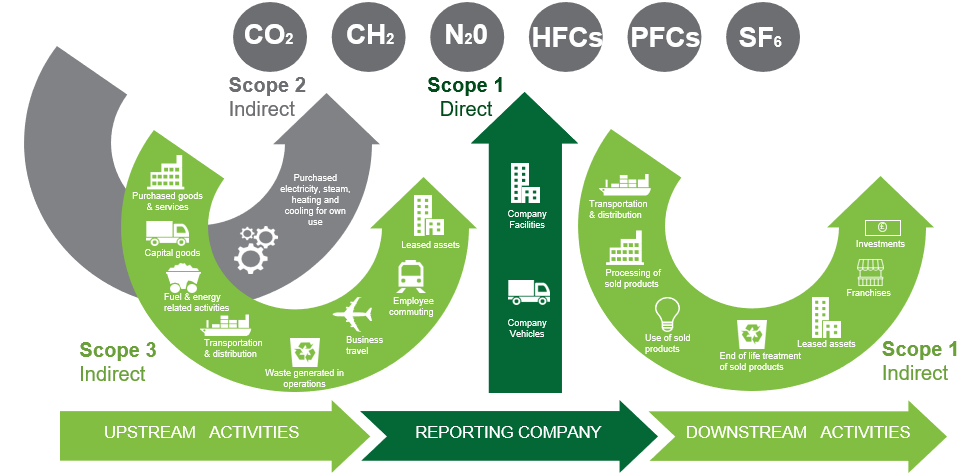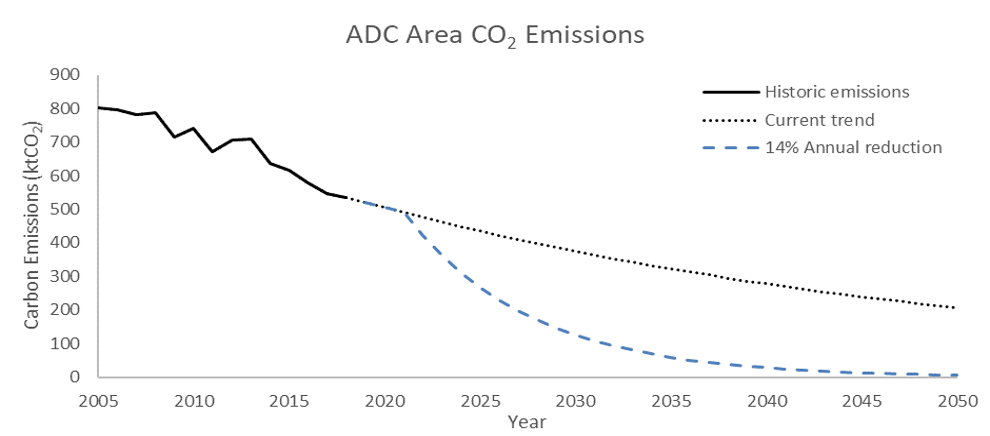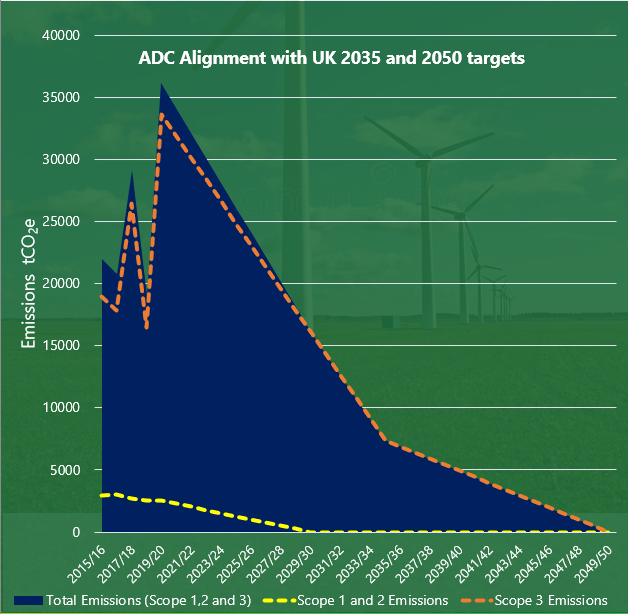Climate change strategy and carbon management plan
Climate change strategy 2021 to 2026
Foreword
Ashfield District Council formally recognises the scale and urgency of the global challenge from climate change and that local action on global warming can make a difference. In a full Council meeting on September 2019, Ashfield District Council made a commitment to do everything possible to combat climate change.
There is clear scientific evidence that our climate is changing as a direct result of human activity, and the impacts of climate change are already being felt across the world. The Earth's atmosphere is warming, faster than it probably ever has. In some cases weather patterns, climates and natural environments are changing quicker than wildlife or people can adapt. It is clear that if the current rate of global heating continues, the effects for humanity and biodiversity will be catastrophic. The window for taking action to limit these effects is reducing rapidly, which makes it so important to start taking action now before it’s too late.

The Council is keen to play a local leadership role on climate change issues by taking action to reduce our own emissions, which is where we have the greatest degree of control and impact. We will also work to influence and assist the wider community emissions to reduce Ashfield’s overall carbon footprint.
Cllr Jason Zadrozny
Leader of the Council
1. Introduction
1.1 Background
Globally, climate change has become a cause for concern, with human activities dangerously increasing greenhouse gas emissions. Human actions have already caused global temperatures to rise by 1ºC, by releasing CO2 and other gases. As a result, our climate is changing rapidly risking our wellbeing and survival and placing a huge burden on the next generation. Urgent action is needed by all sectors in the coming decade and beyond to halt this trend. The intergovernmental panel on Climate Change has recognised that if the climate increases beyond 1.5ºC we risk a climate breakdown as we reach a ‘tipping point’ when efforts to cut emissions are overwhelmed. Reaching this point is a great threat to humanity as the impacts of global warming will become even more extreme and frequent. If CO2 emissions continue at their current rate, we can expect to reach 1.5ºC at some point between 2030 and 2050. To prevent this, we must cut CO2 emissions drastically by 2030 and reach net zero emissions by 2050.
The Climate Change Act was passed in 2008 and set out a legally binding emissions reduction target of reducing greenhouse gas emissions by 80% by 2050. However, in May 2019 a report by the Committee on Climate change resulted in Central Government revising its targets to achieving Net Zero emissions by 2050 and with an interim target of 78% reductions by 2035. This is a big challenge and Ashfield District Council intends to play its part in achieving this.
Ashfield District Council recognises the scale and urgency of the global challenge from climate change and that local action on global warming can make a difference. In a full Council meeting on 26 September 2019 Ashfield District Council made a commitment to do everything possible to combat climate change.
First and foremost, the Council should lead by example, and as a consequence, will:
- Work to reach net zero, or closely to it as possible for the Council’s Direct and Indirect (Scope 1-2) emissions by 2030, and work to minimise scope 3 emissions (outside the Council’s direct control) by
- Work to influence and assist the wider
community emissions to reduce Ashfield’s overall carbon footprint, whereby District wide emissions need to reduce significantly year on year from 2022 to 2050 in order to keep emissions below the carbon budget (the maximum carbon to be emitted by the District) and achieve net zero emissions by 2050, in line with national targets.
Alongside reducing the Council’s own emissions, Ashfield District Council recognises the importance of supporting the decarbonisation of the whole Ashfield District, in line with the UK Government targets of achieving net-zero by 2050 and the international target of keeping global temperature rise well below 2ºC.
ADC has already made significant steps in reducing carbon emissions through multiple different projects, including installing solar PV on many council owned buildings, operating smarter working practices in council offices, launching a Climate Change Officer Working Group to collaboratively drive reductions in carbon emissions, and assessing the impact on sustainability and the environment of its decision making processes. A Carbon Management Plan is in place to analyse the trends of remaining emissions and set out actions to deliver reductions in carbon (and carbon equivalent) emissions.
In conjunction with the Carbon Management Plan, this Climate Change Strategy sets out the current challenges and opportunities faced, and how meaningful change can be achieved within this context.
1.2 The purpose of the climate change strategy
This climate change strategy sets out a road map for reducing carbon emissions across Ashfield District
Council’s operations and services. The Council provides a wide range of services to its local residents across the District and is one of the largest employers in the area. These services include Housing, Parks and Green Spaces, Waste and Environmental Services, Environmental Health, Planning and Economic Regeneration. Therefore, the Council is well placed to have a positive impact on climate change in the area, which can be achieved through:
- Establishing and understanding current emissions (carbon baseline)
- Setting carbon reduction targets
- Setting out key actions to reduce carbon emissions (Carbon management plan)
- Gathering and maintaining high quality emissions data and monitoring improvements over time
- Supporting decarbonisation of the District
The Strategy will be reviewed annually and/or when significant change occurs in order to take consideration of emerging renewable technologies, changes to Government targets, legislation, and funding opportunities, along with taking advantage of existing and emerging opportunities and developments in the energy market.
This Strategy uses a baseline year of 2019/2020 to set reduction targets and monitor emissions going forward. The Council’s carbon emissions (for which we have direct control over) was 2,531 tCO2e in 2019/2020. The wider context Ashfield Area (District) Emissions (Scope 1 and 2 only) was 536,000 ktCO2e in 2018 (figures will be updated as they become available).
1.3 Policy context
The most significant national policy relating to climate change is the Climate Change Act 2008, which set out the national goal for achieving an 80% reduction of greenhouses gases (1990 levels) by 2050 (as amended in 2019 to 100% reduction) and also established the Committee for Climate Change.
Other relevant legislation includes:
- Paris Agreement 2015 which requires international collaboration to prevent climate change
- The Kyoto protocol which commits industrialised countries to individual targets for greenhouse gas emissions
- The Carbon Plan 2011 which sets out a UK strategy for achieving emission reduction promised in the first four carbon budgets
- Clean Growth Strategy 2017 which sets out the central government proposal for decarbonising all sectors of the economy through the 2020’s
In the past 12 months there have been a vast number of policy announcements from Central Government, most notable the 10 Point Plan for a Green Industrial Revolution. A wide range of funding streams have been released to support the acceleration of this. Ashfield District Council has already successfully bid for funding through these streams and will continue to bid for future funding to facilitate change in Ashfield and promote the aims of this climate change strategy.
There is extensive and ever-changing legislation issued by central government around how we should tackle climate change. One of the challenges faced will be adapting to policy change and meeting any new corresponding targets, aligned to available funding.
1.4 Ashfield District Council's emissions
The Council has updated its greenhouse gas emissions profile, established in line with the Greenhouse Gas (GHG) Protocol. This methodology is compliant with UK Government reduction targets, Global Covenant of Mayors, and the Carbon Disclosure Programme (CDP).
The Council has taken into account both direct and indirect organisational emissions from its own operational estate. The emissions are reported across three different scopes:
- Scope 1 - Direct emissions from ADC controlled or owned sources
- Scope 2 - Indirect emissions from the generation of purchased energy used by ADC
- Scope 3 - Indirect emissions associated with the value chain of the Council, both upstream into the Council and downstream out of the

1.5 Ashfield District Council's carbon footprint
Ashfield District Council has set a target of Net Zero for Scope 1 and 2 Emissions by 2030.
The Council’s total (Scope 1, 2 and 3) Carbon Footprint calculated for the 2019/2020 financial year was 36,137 tCO2e. This has been calculated from:
- Energy consumption in council-operated buildings and emissions associated with refrigerant
- Fuel consumption of the Council’s vehicle fleet
- Goods and services purchased by the Council (e.g. materials, components, parts, office furniture, office supplies and IT)
- Capital goods purchased by the Council (treated as fixed assets or as plant, property, and equipment. Examples include machinery, construction, buildings, facilities, and vehicles).
- Fuel and energy related activities undertaken by the Council
- Upstream transportation and distribution of supplying goods/services to the Council
- Disposal and treatment of waste generated by the Council
- Business travel and employee commuting
- Leased assets (leased from and leased to the Council)
- Investments made by the Council e. financial, property outside the district etc.
The Council’s carbon footprint for scope 1 and 2 emissions (based on analysis by Nottingham City Council) was 2,531 tCO2e in 2019/2020. It is the Council’s intention to reduce these emissions to net zero by 2030 (or closely to it as possible). Although the focus will be on reducing emissions from their source, where possible, it will be necessary to carry out carbon offsetting measures e.g. planting trees or Renewable Energy Certificates (REC) (carbon credits) to reach carbon neutral.
Scope 1 and 2 emissions 2019 to 2020
Within the Council's direct control.
| Type | Percentage |
|---|---|
| Gas | 37.9% |
| Biomass | 0.3% |
| Fleet | 39.9% |
| Fugitive emissions | 0.1% |
| Electricity | 21.7% |
Scope 3 emissions 2019 to 2020
Outside of the Council's direct control.
| Type | Percentage |
|---|---|
| Purchases goods and services | 11.9% |
| Capital goods | 12.1% |
| Fuel and energy related activities | 1.6% |
| Upstream transportation and distribution | 3% |
| Waste generated in operations | 0.1% |
| Business travel | 0.2% |
| Employee commuting | 2.7% |
| Downstream leased assets | 0.3% |
| Investments | 67.7% |
1.5.1 Area wide (District) emissions
The District’s total area emissions were estimated to be in the region of 770 thousand tonnes of carbon dioxide (ktCO2) in 2018, of which approximately 536,000 tonnes were attributable to Scope 1 and 2 emissions alone. The Scope 1 and 2 emissions mix was 41% domestic, 33% industrial and commercial and 26% from the transport sector.
Ashfield District Council's area emissions 2018
| Type | Percentage |
|---|---|
| Industry and Commercial | 33% |
| Transport | 26% |
| Domestic | 41% |

Over the last 14-year period, Ashfield’s Scope 1 and 2 emissions have on average reduced by 2.94% per year. If this trend was to continue Ashfield area would not reach the net zero target, as emissions would still be 375 ktCO2 in 2030 and 206 ktCO2 in 2050. This demonstrates the need for Ashfield’s area emissions to reduce at a greater rate and magnitude than the historic trend.
Research data by the Tyndall Centre for Climate Change suggests the Ashfield area has a carbon budget of 4 MtCO2 for emissions between 2020 and 2100. If Ashfield emissions continued on the historic trend, this budget would be used up during 2028. All emissions past this point would be contributing to a dangerously warmer world. In order to keep emissions below this carbon budget and achieve net zero emissions by 2050, in line with national targets, annual emissions reduction rates must be in the region of 14% per year, from 2022 to 2050.
1.6 Road map for reducing carbon emissions

The Council will set high level short, medium, and long-term actions to reduce emissions and implement recommendations for suitable metrics and monitoring. Early action is required to maximise the compound savings/benefit and meet the Government’s revised emissions reduction targets. More details of these actions can be found in the Carbon Management Plan.
To reduce the Council’s scope 1 and 2 emissions and achieve net-zero ambitions the main priority will be the decarbonisation of heating systems in Council operated buildings and decarbonisation of the Council’s fleet. In order to reduce the Council’s scope 3 emissions it will be necessary to decarbonise the goods and services purchased by the Council, and all commercial investments made by the Council. This will require significant and rapid change within the supply chain in order to provide the Council with purchasing and investment options to enable this to happen. Steps to achieve this are provided in the Climate Change Action Plan.
2. Delivery themes
2.1 Transport
Emissions from the transport sector are one of the major contributors to climate change nationally, and this trend is reflected within the Council. In 2019/2020 emissions from fleet use contributed the largest proportion of scope 1 and 2 emissions. Therefore, to reach net zero by 2050 significant changes need to be made. One of the emerging opportunities for carbon reduction in transport is through technological development in electric vehicles (EV) and/or hydrogen powered vehicles.
Central Government have announced that from 2030 the sale of new petrol and diesel cars will be no longer be permissible. As technology in the market advances, the Council will be able to increase its use of electric vehicles by purchasing and/or leasing more electric vehicles as part of the Council fleet. There will also be wider encouragement of electric vehicles for business use and commuting, aided by increasing the numbers of charging points available to the Council and the wider public.
The impact of COVID-19 has led to more flexible and remote working, which has dramatically reduced emissions during 2020/2021 from business travel and commuting. This has also led to the Council being able to reduce its office capacity requirements, enabling further emissions reduction.
Opportunities
- Conduct a fleet management review and consider full electrification of the Council’s fleet vehicles - to meet the Government’s target of zero new vehicle transport emissions by 2035
- Invest in electric machinery, such as strimmers and lawn mowers
- Prioritise low carbon modes of business travel and consider the use of electric pool cars
- Introduce policies which align to use of ultra-low emission vehicles e.g. essential/casual car user
- Promote more sustainable methods of employee commuting, such as cycle to work schemes, car sharing and electric vehicle charging points
- Invest in walking and cycling infrastructure and pedestrianising the high street where possible
- Continue to promote agile working to reduce commuting and business travel requirements
2.2 Housing
Housing is another key area of focus as it is responsible for around 20% of UK emissions, which will require complete decarbonisation in order to meet emissions targets. Whilst the emissions from Council owned housing is not included in the carbon zero target, it is important that these emissions are addressed as part of the decarbonisation of the District. The Council’s housing stock comprises 6632 properties, and whilst the Council aims to continue investment in improving the thermal efficiency and carbon footprint of its domestic stock, it will be reliant on significant Government funding to achieve this. Currently the Council has a number of initiatives to reduce carbon emissions of the housing stock across all tenures, including bidding for Central Government funding streams as and when they arise and carrying out subsequent projects/works. Examples include the Green Homes Grant, Social Housing Decarbonisation Fund and Low Carbon Skills Fund. The Council will continue to seek such funding and deliver carbon reduction projects which in turn will assist to reduce fuel poverty and support low-income households.
Legislatively as a landlord, the Council must ensure that all its properties are brought up to a thermal efficiency level of EPC level C minimum by 2030 and cease the installation of natural gas boilers by 2035. The Council also has a role via Environmental Health to enforce energy efficiency in the private rented sector. All of which will assist in lowering carbon output in the domestic rental market.
Opportunities
- Where practically possible, seek to reduce the emissions associated with the housing stock. This will be done by taking a fabric first approach initially, followed by renewable heating/energy production;
- Carry out a fuel poverty impact assessment for any decarbonisation projects that will increase fuel costs for the tenant or resident enabling residents adversely effected to be assisted;
- Continue to explore funding opportunities for improving the energy performance rating and decarbonisation of its own housing stock and in the private sector;
- Support residents to be more resource efficient in terms of energy and water use through the support and promotion of retrofitting schemes, to enhance the efficiency of homes and their energy systems;
- Explore procurement opportunities to minimise carbon emissions from development projects.
2.3 Energy
Gas and electricity used for heating, power and lighting to the Council’s assets and activities are the second and third largest contributors to the Council’s carbon emissions respectively, and so are also key areas when looking to reduce the Council’s carbon footprint. As with housing, the priority will be to take a ‘fabric first’ approach across its assets to reduce the amount of energy required, however we must also consider low carbon energy options. In the UK the electricity provided by the national grid is generated from increasingly ‘green’ sources such as wind, solar and hydro energy, which has contributed to the reduction in emissions over the last 5 years. The Council has switched to the purchase of electricity from renewable sources which will effectively reduce emissions from electricity to zero. Whilst this is a positive step, in order to achieve net zero carbon emissions by 2050 we will have to take ambitious action and consider alternative renewable energy sources to fully replace fossil fuels as a means of providing heating. Renewable energy presents both a great solution and an exciting opportunity as technology develops rapidly.
As part of the Government’s 10 Point Plan, over the next 15 years fossil fuel boilers will be removed from the market. While Hydrogen technology is currently being developed and may prove an effective alternative in the coming years, it is not yet readily available. This means the use of direct electric heating systems currently remains the dominant ‘cleaner and greener’ source of heating provision. Heat pumps still require electricity to power them and so the switch to the purchase of green electricity will ensure that emissions are low. The Council has already taken steps to increase the use of renewable energy to provide power and heating, including the installation of numerous Solar PV systems across the estate, as well as 3 combined heat and power systems, and 2 large scale communal Biomass heating systems.
Opportunities
- Promote low carbon and sustainable procurement through qualitative assessments of carbon credentials within scoring criteria, and performance monitoring;
- Review Contract Procedure Rules and Sustainability Policy and explore options to implement low carbon Procurement Guidance;
- Consider travel distances, methods of transport and fuel type to transport goods and services to the Council where
2.4 Waste
The Council is committed to minimising the creation of waste, pollution and carbon emissions through effective waste management and setting realistic targets. We can tackle climate change by making the most of the resources we already have and being more efficient in the way we use these resources. In 2019/2020 the waste generate by the Council was 50.3 tCO2e. In order to reach net zero this needs to be reduced significantly. One way of reducing waste is though the promotion of a more circular economy through recycling, repairing and reusing goods, which in turn would result in less waste sent to landfill. This extends to wastewater which makes over one fifth of the Council’s waste emissions for 2019/2020.
Reducing waste through greater recycling, repairing and reusing goods will reduce carbon emissions and reduce the cost to the Council and wider community.
Opportunities
- Respond to the government waste strategy and refine the Council’s approach;
- Reduce the total volume of waste generated where possible through greater reuse, and behavioural change campaigns;
- Investigate the potential to increase water re-use, for example through grey water recover systems to reduce wastewater;
- Promote the ‘Reduce, Re-use, Recycle’ Waste hierarchy throughout the Council and the community;
- Where possible eliminate food waste going to landfill;
- Use of targeted communication campaigns to help residents recycle more and waste
2.5 Procured goods and services
The Council will always aim to purchase goods and services from companies with a commitment to the environment and with good carbon credentials, increasingly including social value and environmental considerations and requirements in larger procurement activity. In doing this, the hope is that companies who wish to sell goods and services to the Council will respond by undertaking an environmental commitment, where they have not already done so. However, for the Council to be able to purchase carbon friendly products, the supply chain will need to provide greater choice in the market. Government pressure on such companies and pending legislation will assist the Council to procure goods and services with lower carbon footprints.
Opportunities
- Promote low carbon and sustainable procurement through qualitative assessments of carbon credentials within scoring criteria, and performance monitoring;
- Review Contract Procedure Rules and Sustainability Policy and explore options to implement low carbon procurement guidance;
- Consider travel distances, methods of transport and fuel type to transport goods and services to the Council where applicable.
2.6 Investments
In order to deliver essential public services against a backdrop of reduced funding, many Council’s across the country have needed to invest in commercial property to ensure financial sustainability. Ashfield District Council is no different. However, all purchases have a carbon footprint, and as a consequence of increased commercial activity, the Council’s emissions have increased significantly in recent years. Investments count for by far the largest of the Council’s scope 3 emissions. In 2019/2020 investment activities accounted for 68% of all scope 3 emissions, compared to only 22% in 2015/2016.
Whilst the total emissions figure has increased in the previous 5 year period, if you remove property investments from this the carbon emissions has actual decreased by 28%. Taking this into account, there is still a need to reduce the net carbon cost of the Council’s land and property assets. This can be done through rationalisation, third party rental/income generation and operating efficiencies. The carbon emissions of any investment need to be considered from the outset.
Opportunities
- Undertake a detailed analysis of current investment emissions and research potential low carbon investments in order to inform future investment decisions;
- Investigate ways of reducing investment emissions g. directly financing projects that reduce greenhouse gases.
2.7 Climate resilience and biodiversity
We are already seeing the impact of climate change through extreme weather events such as hotter summers, colder winters, and flooding, and this is only going to continue over time.
Being able to respond to these changes through climate resilience will be a key challenge faced by the Council. As flood risk increases the Council will need to take action to protect communities from the damage flooding can cause. The Council has worked with Nottingham County Council to deliver flood protection measures to properties within the District considered at risk of flooding.
It is also important to promote biodiversity, as this will not only have an immediate positive impact on green spaces in the community, but also help to offset any carbon emissions in the future. Where carbon emissions cannot be removed, it will be necessary to offset this carbon with measures such as tree planting. The Council aims to not only maintain the current biodiversity by encouraging wildlife and also by planting more trees to help these ecosystems grow and flourish.
Opportunities
- Explore mechanisms to promote tree planting on Council land and with local businesses;
- Explore opportunities for carbon sequestration (carbon capture and storage);
- Ensure flood risk is reduced through the flood risk management schemes;
- Maintain green spaces and encourage biodiversity in these spaces;
- Work with schools and community groups to improve knowledge and understanding of biodiversity.
2.8 Partnership and collaboration
The carbon emissions of the Council make up only a fraction of the overall emissions of the District. The Council must therefore encourage, assist the wider District to play its part in mitigating climate change, including enforcement where appropriate. The Council will continue to promote carbon awareness to its employees along with the wider public to better inform decision making.
The Council has limited scope to impact upon its Scope 3 emissions but will endeavour to continually reduce them wherever possible. In respect of area wide emissions, the Council will work collaboratively with the community and develop partnerships with key stakeholders.
Demonstrating good environmental practices and leading by example allows the Council to educate, influence, and encourage emissions reductions. The Council recognises that there is already a wealth of local knowledge and skills relating to climate change mitigation, and so it essential to capture the community’s drive and ambition, and to use it to strengthen the local economy through supporting business development in carbon reduction activities.
Opportunities
- Support individuals and local businesses and promote good sustainable behaviours;
- the Council’s Green business scheme and other initiatives;
- Work with and influence community volunteers and local businesses to help the environment to encourage an increase in ownership of community open spaces;
- Collaborate with communities within the District of Ashfield to create, protect and manage local green infrastructure, increase biodiversity and provide accessible environments, aided by relevant funding e.g. Towns Fund;
- Encourage and influence reductions in carbon emissions associated with new developments in Ashfield through the Local Plan;
- Work collaboratively with peers, industry, and government to jointly develop regional and national resilience.
3. Summary
In conclusion, Ashfield District Council recognises the disastrous impact climate change will have if we do not take steps now to prevent reaching a climate breakdown. The Council is already taking steps to protect Ashfield residents from extreme weather events and flooding, whilst also working to reduce carbon emissions and prevent global temperature rise. However, the scale of the challenge goes beyond the scope of the Council and so cannot be faced alone. We need the support of communities, residents, and local businesses to tackle this challenge head on and create a better, green world for future generations.
Glossary
- ADC - Ashfield District Council
- CO2 - Carbon dioxide
- CO2e - Carbon dioxide equivalent emissions (a term for describing different greenhouse gases in a common unit)
- tCO2e - Tonnes of carbon dioxide equivalent
- KtCO2e - Kilotonnes of carbon dioxide equivalent CH2 Methylene (greenhouse gas)
- N2O - Nitrous oxide (greenhouse gas)
- HFC’s - Hydrofluorocarbons (greenhouse gas)
- PFC’s - Perfluorinated compounds (greenhouse gas) SF6 Sulfur hexafluoride (greenhouse gas)
- KtCO2 - Kilotonnes of carbon dioxide
- MtCO2 - Megatonne (million metric tons) of carbon dioxide
- EPC - Energy performance certificate (gives an energy efficiency rating and an environmental impact rating of a property).
- Greenhouse gases - The gases responsible for the greenhouse effect (carbon dioxide, methane, nitrous oxide, and water vapour (which all occur naturally), and fluorinated gases (which are synthetic)
